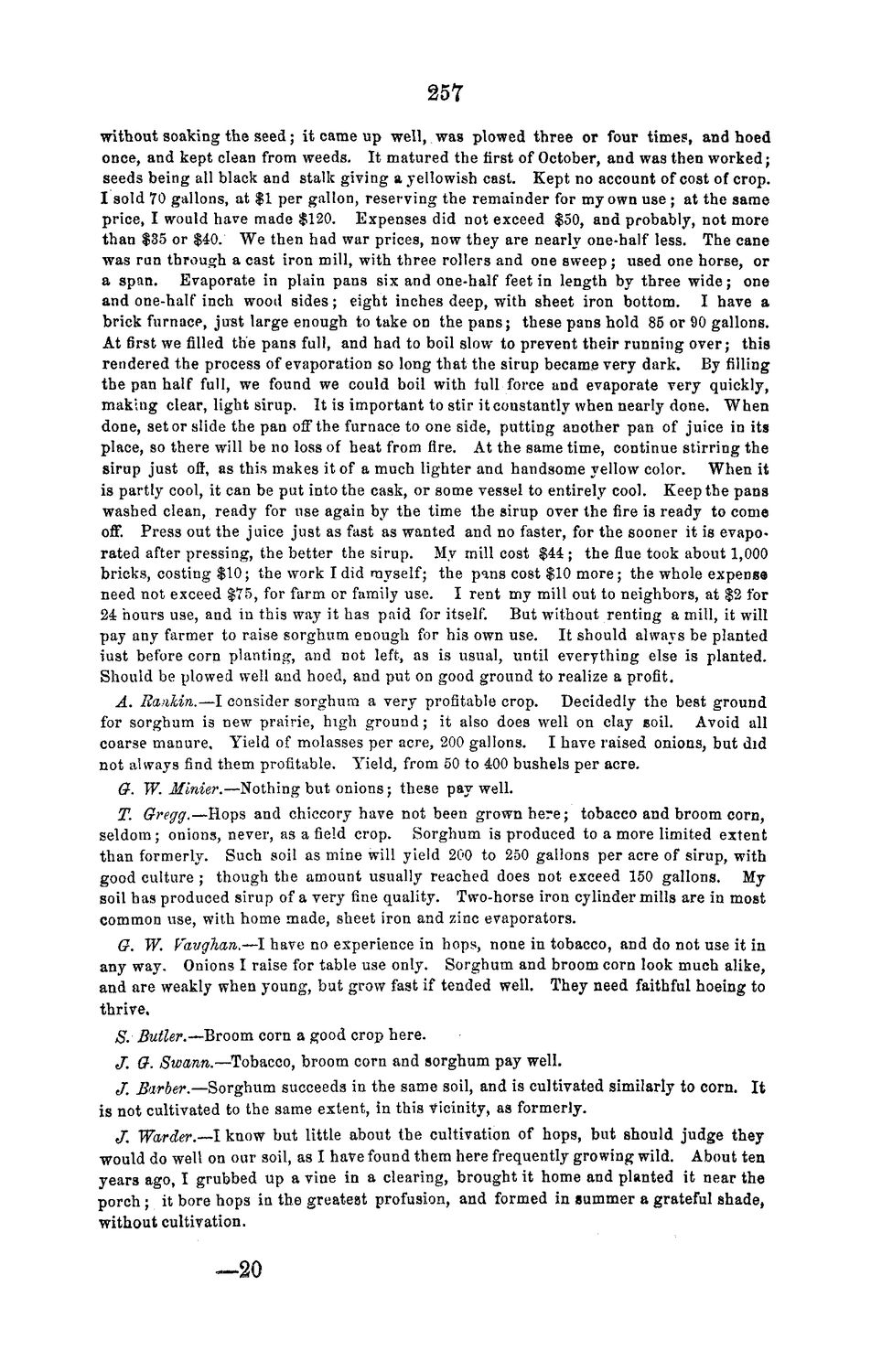| |
| |
Caption: Board of Trustees Minutes - 1868
This is a reduced-resolution page image for fast online browsing.

EXTRACTED TEXT FROM PAGE:
257 without soaking the seed; it came up well, was plowed three or four times, and hoed once, and kept clean from weeds. It matured the first of October, and was then worked; seeds being all black and stalk giving a yellowish cast. Kept no account of cost of crop. I sold 70 gallons, at $1 per gallon, reserving the remainder for my own use ; at the same price, I would have made $120. Expenses did not exceed $50, and probably, not more than $35 or $40. We then had war prices, now they are nearly one-half less. The cane was run through a cast iron mill, with three rollers and one s w e e p ; used one horse, or a span. Evaporate in plain pans six and one-half feet in length by three w i d e ; one and one-half inch wood s i d e s ; eight inches deep, with sheet iron bottom. I have a brick furnace, j u s t large enough to take on the p a n s ; these pans hold 85 or 90 gallons. At first we filled the pans full, and had to boil slow to prevent their running over; this rendered the process of evaporation so long that the sirup became very dark. By filling the pan half full, we found we could boil with full force and evaporate very quickly, making clear, light sirup. It is important to stir it constantly when nearly done. When done, set or slide the pan off the furnace to one side, putting another pan of juice in its place, so there will be no loss of heat from fire. At the same time, continue stirring the sirup just off, as this makes it of a much lighter and handsome yellow color. When it is partly cool, it can be put into the cask, or some vessel to entirely cool. Keep the pans washed clean, ready for use again by the time the sirup over the fire is ready to come off. Press out the juice just as fast as wanted and no faster, for the sooner it is evaporated after pressing, the better the sirup. My mill cost $44 ; the flue took about 1,000 bricks, costing $10; the work I did myself; the pans cost $10 m o r e ; the whole expense need not exceed $75, for farm or family use. I rent my mill out to neighbors, at $2 for 24 hours use, and in this way it has paid for itself. But without renting a mill, it will pay any farmer to raise sorghum enough for his own use. It should always be planted iust before corn planting, and not left, as is usual, until everything else is planted. Should be plowed well and hoed, and put on good ground to realize a profit. A. Rankin.—I consider sorghum a very profitable crop. Decidedly the best ground for sorghum is new prairie, high g r o u n d ; it also does well on clay soil. Avoid all coarse manure. Yield of molasses per acre, 200 gallons. I have raised onions, but did not always find them profitable. Yield, from 50 to 400 bushels per acre. G. W. Mlnier.—Nothing but onions; these pay well. T. Gregg.—Hops and chiccory have not been grown h e r e ; tobacco and broom corn, seldom; onions, never, as a field crop. Sorghum is produced to a more limited extent than formerly. Such soil as mine will yield 200 to 250 gallons per acre of sirup, with good culture ; though the amount usually reached does not exceed 150 gallons. My soil has produced sirup of a very fine quality. Two-horse iron cylinder mills are in most common use, with home made, sheet iron and zinc evaporators. G. W. VaugTian.—I have no experience in hops, none in tobacco, and do not use it in any way. Onions I raise for table use only. Sorghum and broom corn look much alike, and are weakly when young, but grow fast if tended well. They need faithful hoeing to thrive, S. Butler.—Broom corn a good crop here. broom corn and sorghum pay well. It J. G. Swann.-Toba.cco, J. Barber.—Sorghum succeeds in the same soil, and is cultivated similarly to corn. is not cultivated to the same extent, in this vicinity, as formerly. J. Warder.—I know but little about the cultivation of hops, but should judge they would do well on our soil, as I have found them here frequently growing wild. About ten years ago, I grubbed up a vine in a clearing, brought it home and planted it near the porch ; it bore hops in the greatest profusion, and formed in summer a grateful shade, without cultivation. —20
| |